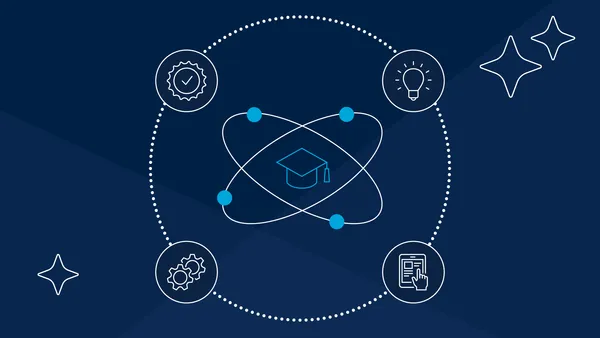More than 30 million adults in the U.S. have some college credit but no degree — a massive chunk of the potential market for postsecondary education that more institutions are turning their attention to.
Meanwhile, employers are doubling down on education benefits, in some cases giving their workers ways to earn full degrees or certificates for free or at a steep discount. It reflects the burgeoning sentiment that corporations should invest in their workers' futures.
In recent months, employers including Walmart, Chipotle, JetBlue and Uber have expanded or bolstered their corporate education benefits.
And universities are finding ways to tap into that demand, whether through third-party brokers or by connecting directly with employers.
"The challenge is not presenting a benefit," but rather ensuring that students who partake in it achieve educational outcomes that can "meaningfully change the trajectory of their lifetime earnings," said Steve Ellis, co-managing partner of The Rise Fund.
Earlier this year, the impact investment arm of private equity firm TPG partnered with Arizona State University to launch a venture designed to connect companies and colleges for employee education. InStride has added partner universities worldwide — including in Australia, Ireland and Mexico — in the hopes of working with companies across international borders.
Founded in 2016, the fund manages more than $4 billion and has invested in more than 25 businesses. The individual fund invested in InStride is $2.1 billion.
Along with InStride, The Rise Fund's education investments include Digital House, which offers digital skills training to professionals in Latin America. Arizona State, meanwhile, has garnered attention for its corporate education partnerships with Starbucks, Uber and others.
We spoke with Ellis and John Rogers, The Rise Fund's education sector lead, about how they view employer demand for education, colleges' role in addressing it and why it’s investing in InStride.
This interview has been edited and condensed for clarity and brevity.
EDUCATION DIVE: We see more awareness of the need for colleges to prepare workers for changes in the workforce. Is that reflected in the kinds of organizations you are investing in and how you view the market?
JOHN ROGERS: We're focused on solutions that help bridge the gap between education and employment, and digital skills are important. On the one hand, there have been high-quality but expensive and inflexibly delivered degrees. And on the other hand, there has been very acceptable, sometimes free but lower-quality educational content — think YouTube videos.
InStride is a great manifestation of the need to fill that gap. We didn't find an existing company in which to invest. Instead, we helped build a new one where the goal is to reach working adults where they need educational content the most, which is in the workplace.
STEVE ELLIS: The obligation to onboard students and manage their learner journeys is something our investment in InStride would suggest needs to be more of a responsibility for large employers where education is a benefit just the way healthcare is a benefit. There should be an expectation that they are investing in their employees to continue to upgrade their skills and help them advance both within and outside of their companies.
It's a subtle difference in terms of who's providing and delivering curriculum and who's responsible for guiding adult learners through the process of getting an education.
What role do traditional colleges and universities play, in that case?
ELLIS: Many leading higher ed institutions are attempting to respond to this need in their graduate programs and executive education. Many are offering coding academies. They are doing what they can to respond to a necessary evolution in higher education. At some level, this also threatens what has traditionally been the mainstays of higher education in the U.S.: large, location-based campuses, and the influence and role of faculty.
This is why I think Arizona State's embrace of online learning has been such a game-changer. They've found a way to bring the faculty along in the process of creating a blended and purely online curriculum for people who otherwise wouldn't have access to the kinds of education they're so uniquely capable of delivering. I think the larger, most prominent higher ed institutions in the U.S. are waking up to this, but they need to move more quickly to be as relevant to the future as I think they aspire to be.
What made InStride an attractive investment?
ELLIS: Arizona State's position in the market, its commitment to building a world-class, global, online four-year curriculum, and the leadership that its president, Michael Crow, has provided for that institution, along with his commitment to commercializing and dramatically accelerating the adoption of these programs across corporate America, was really unique. He needed a partner that was committed to Arizona State's social mission.
We needed somebody willing to accept that we needed a network of universities as part of this endeavor. That's not something you often see among leaders of prominent higher ed institutions. Embracing that part of the model is absolutely critical to ensure we brought to this really important channel for adult learning — i.e., large global corporations — a network of the highest-quality curriculum, higher quality than anything available online today.
How does the global nature of InStride's university network impact the partnership?
ELLIS: It is to ensure we can serve global pools of employees. If you're working for a Starbucks or driving for Uber in Sydney, affiliation with the University of New South Wales means more than it would if you were in Phoenix, even though you're getting all of your education online.
Do you expect to see more offshoots of universities or partnerships between universities and other organizations focused on workforce education?
ROGERS: We found companies, whether they were MOOCs or online program managers, pivoting toward business-to-business and a degree-completion orientation. None were really purpose-built for that. So I think InStride is in a better position to serve those customers with that goal.
But yeah, you'll see that demand reflected in other spinouts in the market and different ways universities are looking to expand their reach.
ELLIS: Not everyone's going to be part of our network. And I think people are going to see the power and demand once what I think is a bit of a zeitgeist shift takes hold. That's a good thing. A big part of our impact thesis is that we're going to catalyze a bunch of change that ensures employers and, therefore employees, have more educational choice.
But to make this work at scale, you need a built-for-purpose tech stack, learner journey, reporting, dashboarding. That is a huge lift, and it's not something that can be borne from an OPM model or an existing MOOC model. It has to be built to address the enterprise-scale needs of large corporations and their employees.




















